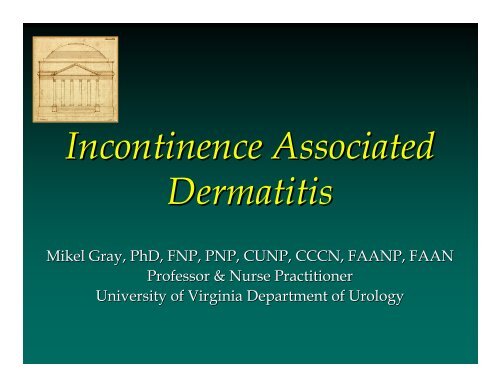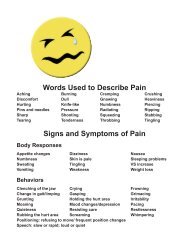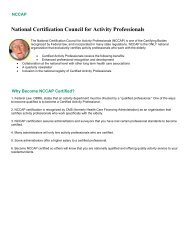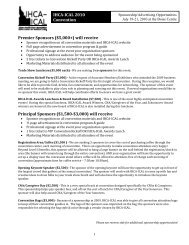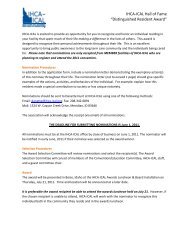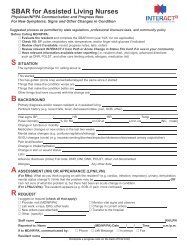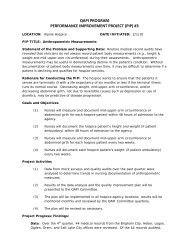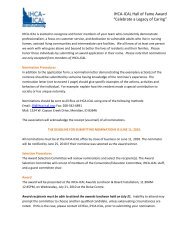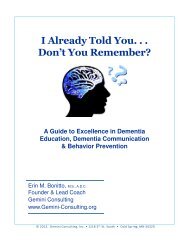Incontinence Associated Dermatitis
Incontinence Associated Dermatitis
Incontinence Associated Dermatitis
You also want an ePaper? Increase the reach of your titles
YUMPU automatically turns print PDFs into web optimized ePapers that Google loves.
<strong>Incontinence</strong> <strong>Associated</strong><br />
<strong>Dermatitis</strong><br />
Mikel Gray, PhD, FNP, PNP, CUNP, CCCN, FAANP, FAAN<br />
Professor & Nurse Practitioner<br />
University of Virginia Department of Urology
Functions of the Skin<br />
Thermoregulation<br />
Sensory organ/<br />
communication<br />
Immune functions; acts as a<br />
first line of defense<br />
Vitamin D metabolism<br />
Barrier against toxins in<br />
external environment and<br />
against fluid & electrolyte<br />
loss from internal<br />
environment<br />
Burns T et al. Textbook of Dermatology, 2004. Mass: Blackwell Science.<br />
Figure: Verdier-Sevrain<br />
S, Bonte F. Journal of Cosmetic Dermatology 2007; 6:75.
Barrier Function: The Bricks<br />
Corneocytes (keratinocytes)<br />
– Anucleated cells filled with<br />
keratin & other molecules created<br />
by breakdown of filaggrin<br />
– Collectively referred to as natural<br />
moisturizing factor (NMF)<br />
– Surrounded by cornified<br />
envelope (corneodesmosomes(<br />
corneodesmosomes)<br />
that degrade as they move to<br />
surface of skin<br />
– 20% content is H 2 0<br />
Verdier-Sevrain<br />
S, Bonte F. J Cosmetic Dermatology 2007; 6:75.<br />
Gray M. American Journal of Clinical Dermatology 2010; 11(3): 201.<br />
Figure:<br />
http://www.bioskinregeneration.com/wrinkles/skin.j<br />
pg
Moisture Barrier:<br />
Natural Moisturizing Factor (NMF)<br />
NMF contains various hygroscopic molecules 1 :<br />
– Amino acids 40%<br />
– pyrrolidone carboxylic acid 12%<br />
– Lactate 12%<br />
– Urea 7%<br />
NMF levels ↓ by:<br />
– Repeated washing with soaps or detergents 2<br />
– Low humidity (
Skin’s s Moisture Barrier:<br />
The Mortar (Lipid Matrix)<br />
Primary components 1 :<br />
– Ceramides 50%<br />
– Cholesterol 23%<br />
– Free fatty acids 15%<br />
– Organized in lamellar arrangement as bi-layers with<br />
water; stores water needed for adequate hydration and<br />
slows water passage<br />
Lipid Matrix ↓ by:<br />
– Age 2<br />
– Seasonal effects 1<br />
– Atopy 2<br />
1. Verdier-Sevrain<br />
S, Bonte F. Journal of Cosmetic Dermatology 2007; 6:75.<br />
2. Rogers J et al. Archives in Dermatologic Resarch 1996; 288: 756.<br />
3. Chamlin SL et al. Archives in Dermatology 2001; 137: 1110.
Moisture Barrier:<br />
Additional Factors<br />
Aquaglyceroporin AQP3 1<br />
– Membrane protein that forms water channels across<br />
cell facilitating transport of water, urea, glycerol<br />
within epidermis but preventing excessive loss via SC<br />
– Expressed from the granulosum to just below the SC<br />
Tight Membrane Junctions 2<br />
– Water gradient steepest at junction or stratum<br />
corneum and stratum granulosum<br />
– TMJ comprises transmembrane proteins that control<br />
skin permeability<br />
1. Verkman AS, Mitra American J Physiology Renal Phys 2000; 278: F13.<br />
2. Madara JL. Annual Review of Physiology 1998; 60: 143.
Moisture Barrier:<br />
Vulnerable at the<br />
Extremes of Life<br />
Neonates: less efficient moisture barrier,<br />
especially in premature infants 1<br />
– More hydrophobic than older infants; result is<br />
dryer more brittle skin 2<br />
– TEWL ; ; skin capacitance <br />
Cornification begins about GW 20<br />
– Full-term skin contains 10-20 layers of SC, skin<br />
in premature baby has 2-32<br />
3 layers of SC<br />
– Ability to regenerate skin cells considerable<br />
1. Lund C et al. JOGNN 1999; 28(3): 241.<br />
2. Matsumoto T et al. Journal of Dermatology 2007; 34: 447.
Moisture Barrier<br />
Vulnerable at the Extremes of<br />
Life<br />
Aging Skin: gradual decline<br />
in barrier function<br />
– Thickness<br />
– NMF content<br />
– hydration<br />
– TEWL<br />
Comparatively slow to<br />
regenerate<br />
.
Water<br />
Adverse Effects of<br />
Urine on Skin<br />
– skin hardness, rendering it more susceptible<br />
to friction and erosion 1-3<br />
– Compromises barrier function of skin 4<br />
permeability to pathogenic species<br />
permeability to irritants in urine or stool<br />
– Effects exacerbated by presence of occlusive<br />
device such as warp around incontinence<br />
brief<br />
brief<br />
1. Berg W et al. Pediatric Dermatology 1986; 3: 102.<br />
2. Leyden JJ et al. Archives of Dermatology 1977; 113: 1678.<br />
3. Gray M. Journal of WOC Nursing 2004; 31(1 Suppl):S2-9.<br />
4. Zimmerer RE et al. Pediatric Dermatology 1986; 3: 95.
Ammonia<br />
Adverse Effects of<br />
Urine on Skin<br />
– From urine itself; ammonia also produced by<br />
conversion of urea in presence of certain bacteria,<br />
such as Corynebacterium and fungal species such<br />
as candida albicans 1-3<br />
– Especially with double UI & FI<br />
– No direct evidence ammonia damages intact skin;<br />
probably aggravates already compromised skin 1<br />
– Alkaline urine may provoke or exacerbate<br />
inflammation 2<br />
1. Leyden JJ et al. Archives of Dermatology 1977; 113: 1678.<br />
2. Atherton DJ Eur Academy Dermatology Venerology 2001; 15 (Supp1): 1.<br />
3. Berg W et al. Pediatric Dermatology 1986; 3: 102.
Adverse Effects of<br />
Stool on Skin<br />
Fecal enzymes<br />
– Protease & lipase potentially break down both<br />
principal elements of moisture barrier 1,2<br />
– In vivo evidence shows that exposure to<br />
digestive enzymes in human skin led to 3<br />
TEWL<br />
pH<br />
Visible Visible damage only when occlusion present<br />
Evidence Evidence of damage present after 12 days<br />
1. Atherton DJ Eur Academy Dermatology Venerology 2001; 15 (Supp1): 1.<br />
2. Gray M. Journal of WOC Nursing 2004; 31(1 Suppl):S2-9.<br />
3. Anderson PH et al. Contact <strong>Dermatitis</strong> 1994; 30(3): 152.
Pathophysiology<br />
Use of absorptive containment devices<br />
– Exacerbate overhydration by promoting<br />
perspiration & retaining urine and stool; with<br />
padding alone:<br />
TEWL TEWL increases 3-43<br />
4 fold within days<br />
COCO 2<br />
emission increases > 4 fold<br />
pH pH increases from 4.4 to 7.1 (without(<br />
incontinence)<br />
1. Grove GL et al. Clinical Problems in Dermatology 1998; 26:183<br />
2. Zimmerer RE et al. Pediatric Dermatology 1986; 3: 95.<br />
3. Zhai H et al. Skin Research & Technology 2002; 8:13.
IAD: Pathophysiology<br />
Urine/ Stool and Skin Flora<br />
– Flora of skin near groin usually<br />
colonized with staphylococcus<br />
epidermidis & diphtheroids such as<br />
Corynebacterium<br />
– Contains few gram negative bacilli<br />
– Candida albicans found in stool of infants<br />
with diaper dermatitis, but not infants<br />
without dermatitis<br />
Leyden JJ et al. Archives of Dermatology 1977; 113: 1678.
Beekman D et al. Journal of Advanced Nursing 2009; 65(6): 1141.
Definition:<br />
<strong>Incontinence</strong> <strong>Associated</strong> <strong>Dermatitis</strong><br />
(IAD)<br />
Irritation and inflammation<br />
associated with exposure to stool<br />
or urine<br />
Often accompanied by erosion of<br />
the skin<br />
Sometimes accompanied by<br />
secondary cutaneous infection<br />
(ie: candidiasis)<br />
Etiology and pathophysiology<br />
distinct from pressure ulceration<br />
Photograph courtesy Linda<br />
Bohacek
IAD as One Form of<br />
Moisture <strong>Associated</strong> Skin Damage (MASD)<br />
– Intertrigo: : inflammation in skin folds related to<br />
perspiration, friction and bacterial/ fungal<br />
bioburden<br />
– Periwound maceration: : skin breakdown from<br />
wound exudate, related to volume,<br />
constituents or exudate & bacterial bioburden<br />
– IAD: : urine, stool, containment device,<br />
secondary cutaneous infection –fungal or<br />
bacterial<br />
1. Gray M et al. Journal of Wound, Ostomy & Continence Nursing 2007; 2<br />
34(2):134.
Prevalence in Acute Care<br />
976<br />
Total number of<br />
patients surveyed<br />
35% had<br />
Foley catheter<br />
(deemed continent)<br />
20.3% (198)<br />
prevalence of<br />
incontinence<br />
urine or stool<br />
• 27% had IAD<br />
• 33% had a pressure<br />
ulcer<br />
• 18% had a probable<br />
fungal Infection<br />
21% had more than 1 type of injury<br />
Junkin J, Selekof J. IAD prevalence in acute care. WOCN National Conference, June 2006<br />
Minneapolis, MN.
Prevalence in Acute Care<br />
N = 608<br />
33% had<br />
Foley catheter<br />
(deemed continent)<br />
19.7% (120)<br />
prevalence of<br />
incontinence<br />
urine or stool<br />
• 42.5% perineal skin injury<br />
• 20% had IAD<br />
• 21.7% had PU<br />
• 10% had a probable<br />
fungal Infection<br />
Junkin J, Selekof J. Journal Wound, Ostomy & Continence Nursing 2007; 34(3): 260.<br />
.
Prevalence & Incidence<br />
in Critical Care Setting<br />
95% of 44 ICU patients with incontinence<br />
(n=44) 1<br />
MDS mined data suggests at least 5.7%<br />
prevalence from 10, 217 residents in 31 states 2<br />
3.4% incidence in 981 residents on IAD<br />
prevention program (over 14 days)<br />
Median (range) time to onset 13 days<br />
39% still had IAD after 2 weeks<br />
1. Peterson, AACN NTI abstract, 2007.<br />
2. Bliss DZ et al. Nursing Research 2006; 55(4): 243.
Etiology: Pressure Ulcers<br />
Pressure<br />
Shear<br />
Pressure + Shear<br />
Histopathologic Analysis of PU: ischemia 1<br />
1. Houwing RH et al. SKINmed 2007; 6(3): 113.
Etiology: IAD<br />
Histopathologic Analysis of IAD: inflammation 1<br />
1. Houwing RH et al.<br />
SKINmed 2007; 6(3): 113.
IAD & Pressure Ulcers<br />
Most experts believe that IAD impairs skin’s<br />
tolerance for pressure/ shear<br />
Ongoing debate & controversy reflects lack of<br />
knowledge of underlying mechanisms…in in one<br />
study subepithelial moisture differentiated<br />
erythema and stage I PU; higher SEM predicted<br />
greater likelihood of erythema/stage I PU 1<br />
FI and double incontinence strongly associated<br />
with PU risk, mixed evidence concerning UI<br />
alone 2-6<br />
1. Jensen BB. Journal of Wound, Ostomy and Continence Nursing, 20092<br />
(in pres).<br />
2. Maklebust J & Magnan MA Advances in Wound Care 1994; 7(6): 25.<br />
3. Gunninberg L. Journal of Wound Care 2004; 13(7): 286.<br />
4. Fader M et al. Journal of Clinical Nursing 2003; 12(3):374.<br />
5. Berlowitz DR et al. Journal of the American Geriatrics Society 2001; 49(7):866<br />
7):866-71. 71.<br />
6. Narayan S et al. Jounal of WOCN 2005; 32(3): 163.
IAD: Screening begins with CNA<br />
or Non-professional care provider
IAD:<br />
Diagnosis<br />
Relies solely on<br />
inspection<br />
– Inflammation (bright<br />
red) in persons with<br />
light skin tones<br />
– IAD located in skin fold<br />
or underneath<br />
containment device,<br />
borders are poorly<br />
demarcated & irregular<br />
– Surface of skin may<br />
“glisten” owing to<br />
serous exudate
IAD: Diagnosis in persons with<br />
Darker Skin Tones<br />
Inflammation not readily<br />
apparent (ie: not bright<br />
red); often presents as<br />
area of<br />
hyperpigmentation or<br />
subtle red tone<br />
Hypopigmented areas<br />
with chronic<br />
inflammation<br />
Pattern of skin damage<br />
does not vary
IAD: Diagnosis<br />
Inspect Skin Folds<br />
– Opposing skin surfaces trap<br />
& harbor moisture<br />
– Warm moist environment<br />
encourages bacterial and<br />
fungal colonization,<br />
overgrowth and infection<br />
– Friction occurs as skin folds<br />
rub against one another
IAD: Diagnosis<br />
Assess for skin<br />
erosion<br />
– Partial thickness<br />
erosion occurs with<br />
IAD<br />
– Necrotic tissue:<br />
eschar or slough, full<br />
thickness damage<br />
indicates pressure<br />
ulceration
IAD: Diagnosis<br />
Look for secondary<br />
cutaneous infection,<br />
especially candidiasis<br />
– Opportunistic infection with<br />
candida albicans<br />
– Thrives in warm, moist<br />
environment & damages<br />
stratum corneum<br />
– Seen in 18% of one group of<br />
976 acute care inpatients 1<br />
Junkin J, Selekof J. IAD prevalence in acute care. WOCN National l Conference, June 2006 Minneapolis, MN.
IAD: Diagnosis<br />
Suspect PU when wound<br />
is<br />
– Over bony prominence<br />
– Full thickness<br />
– Necrotic tissue is present<br />
– Skin is dark to purplish<br />
red<br />
Images: http://www.lhsc.on.ca/wound/p_chart.htm
Differentiate IAD from<br />
Pressure Ulceration<br />
Gray M et al. Journal of Wound, Ostomy and Continence Nursing 2007; 07; 34(2): 134.
IAD and its Severity<br />
Instrument<br />
Designed and validated by WOC nurses and<br />
their faculty<br />
2 WOC nurses established initial face validity<br />
Content and criterion validity via 9 WOC nurses<br />
in North Central Region of WOCN<br />
Interrater reliability via 247 WOC nurses<br />
attending 2007 National Conference<br />
Descriptive, ranks severity allowing longitudinal<br />
assessment; responsiveness has not yet been<br />
tested<br />
Borchert K et al. Journal of Wound, Ostomy and Continence Nursing 2010; 37(5): 527.
IAD and its Severity<br />
Instrument<br />
Borchert K et al. Journal of Wound, Ostomy and Continence Nursing 2010; 37(5): 527.
IAD and its Severity<br />
Instrument<br />
Borchert K et al. Journal of Wound, Ostomy and Continence Nursing 2010; 37(5): 527.
IAD and its Severity<br />
Instrument<br />
Borchert K et al. Journal of Wound, Ostomy and Continence Nursing 2010; 37(5): 527.
Clinical Evidence: How do we<br />
Prevent and Treat IAD?<br />
Structured skin care<br />
regimen based on<br />
available evidence and<br />
followed routinely<br />
Lyder, Journal of Enterostomal Therapy Nursing 1992<br />
Hunter et al., Journal of Wound, Ostomy and Continence Nursing 20032<br />
Zehrer et al., OWM 2004<br />
Bale et al., J Tissue Viability 2004<br />
Bliss, et al., Journal of Wound, Ostomy and Continence Nursing 20062
IAD: Prevention & Treatment
IAD: Cleanse<br />
When frequent bathing necessary, current<br />
evidence suggests….<br />
– Gentle cleansing: NO scrubbing 1,2<br />
– Select a cleanser with pH close to acid mantle of skin<br />
– Select product that minimizes potential irritants,<br />
scents, etc.<br />
– Towel drying has been found to compromise<br />
moisture barrier, consider no-rinse formulation for<br />
frequent bathing 2<br />
1. Gray M et al. Journal of Wound, Ostomy & Continence Nursing 2007; 2<br />
34(2):134.<br />
2. Voegeli D. Journal of Wound, Ostomy & Continence Nursing 2008; ; 35(1).
Moisturize<br />
Three categories<br />
– Humectants attract water to the skin<br />
– Emollients replace lipids to stratum corneum;<br />
designed to smooth skin surface<br />
– Occlusives act to protect skin from exposure<br />
to moisture and potential irritants; vary in<br />
their ability to maintain skin hydration<br />
– Some prefer emollient based on clinical<br />
considerations, no research available to verify<br />
or refute
Protect<br />
Skin Protectants should<br />
– Act as a “moisture barrier”, , protecting skin from<br />
deleterious effects of exposure to irritants and<br />
excess moisture<br />
– Maintain hydration and favorable skin’s s normal<br />
transepidermal water loss (TEWL)<br />
– Avoid maceration when left on for prolonged<br />
period of time<br />
– Options<br />
Ointment based skin protectants<br />
Liquid acrylates (marketed as a skin barrier)<br />
Gray M. Skin Protectants in the Treatment of Irritant <strong>Dermatitis</strong> In: Sek CK. Advances in Wound<br />
Care, Volume 1. New Rochelle, NY: Mary Ann Liebert, , Inc.
Protect<br />
Ointment based skin<br />
protectants<br />
– Petrolatum: : blend of<br />
castor seed oil &<br />
hydrogenated castor<br />
oil<br />
– Dimethicone: : silicone<br />
based oil<br />
– Zinc Oxide: : white<br />
powder, mixed with<br />
cream or ointment<br />
base
Clinical Evidence<br />
Petrolatum<br />
– Good protection against irritant<br />
– Avoided maceration<br />
– Modest skin hydration<br />
Dimethicone<br />
– Variable protection against irritant<br />
– Modest protection against maceration<br />
– Good skin hydration<br />
Zinc Oxide<br />
– Good protection against irritant<br />
– Did not avoid maceration<br />
– Poor skin hydration<br />
Hoggarth A et al. OWM 2005; 51(12): 30.
Protect<br />
Skin barriers (polymer acrylate)<br />
– Non-alcohol preferred<br />
Less pain<br />
Less drying<br />
No different when compared to ointment based<br />
skin protectants in one robust RCT (powered for<br />
economic rather than efficacy outcomes)<br />
Bliss DZ et al. Journal of Wound, Ostomy & Continence Nursing 2009; 09; 35 (2).
Cleanse, Moisturize & Protect:<br />
Single Step Approach<br />
Disposable Bathing<br />
Cloth: : Cleanses &<br />
moisturizes<br />
Shield Cloths: : Tailored<br />
cloths, cleanse<br />
(chlorhexidine<br />
gluconate), moisturize<br />
(glycerine, aloe),<br />
protect (3%<br />
dimethicone)
Hospital<br />
vs.<br />
Washcloth Disposable<br />
Washcloth
Preventive Skin Care<br />
Typical Protocol<br />
– Routine daily cleansing &<br />
moisturization for all<br />
patients<br />
– For Incontinent and High<br />
Risk Patients<br />
Cleanse, Cleanse, moisturize &<br />
protect daily and after<br />
each major incontinent<br />
episode
IAD: Treatment<br />
Establish or continue structured<br />
program based on “cleanse,<br />
moisturize & protect”, , consider<br />
changing skin protectant<br />
Minimize exposure to irritants<br />
(Aggressively manage UI or FI)<br />
Treat secondary cutaneous<br />
infections<br />
Allow skin to heal or apply<br />
protectant with active ingredients<br />
designed to promote healing
IAD: What about<br />
Dressings<br />
Topical Dressings<br />
– Hydrocolloids<br />
– Thin film dressings<br />
Act as barrier to urine & stool<br />
Promote moist environment<br />
for wound healing<br />
Can be combined with topical<br />
treatments
Dressings:<br />
Practical Concerns<br />
Topical Dressings<br />
– Maintaining adherence<br />
significant challenge<br />
– Skin surfaces complex<br />
– Borders often roll when<br />
ointments or<br />
moisturizing products<br />
have been applied<br />
– Undermining of urine<br />
or stool may occur
IAD Treatment<br />
Aluminum sulphate or acetate (Burow’s<br />
Solution) with Stomahesive powder:<br />
– Applied as compress; causes protein<br />
precipitation & has antimicrobial properties<br />
– Exerts drying & soothing effect; followed by<br />
application of moisture barrier<br />
– Often used when dermatitis complicated by<br />
extensive erosion and serous exudate
IAD: Treatment<br />
BCT Agents<br />
– BCT Ointment (Xenaderm)<br />
Balsam Peru, Castor Oil, Trypsin in<br />
ointment base<br />
Applied to dermatitis twice daily or with<br />
major cleansing<br />
Goal is to combine skin protectant<br />
with active ingredients that promote<br />
wound healing
IAD Treatment:<br />
Secondary Complications<br />
Candidiasis<br />
– Topical antifungals are effective for the<br />
treatment of cutaneous infections<br />
– Effective agents include the polyene<br />
antibiotics, azoles and the allylamines 1<br />
– Resistance to antifungals is emerging, careful<br />
monitoring of research literature is essential<br />
1. Evans E & Gray M, Journal of Wound, Ostomy & Continence Nursing 2003; ,30(1).
Conclusion<br />
IAD is a prevalent and clinically relevant<br />
condition,<br />
Relationship to PU risk poorly understood,<br />
etiology appears distinct, some<br />
pathophysiologic mechanisms shared<br />
Structured skin regimen key to prevent &<br />
treat<br />
Principles of skin regimen: cleanse,<br />
moisturize & protect


